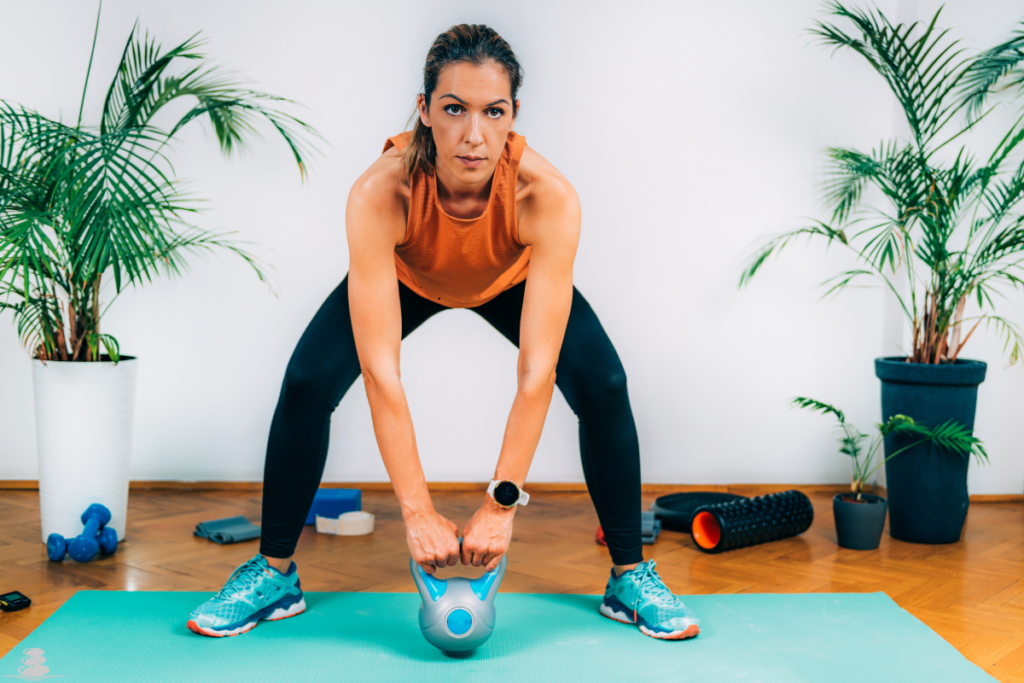What is Kettlebell Training?
Kettlebell training is a unique and powerful form of exercise that uses a cast-iron or steel ball with a handle to perform a wide variety of movements. Unlike traditional dumbbells, which are typically used for isolated muscle exercises, kettlebells are designed for dynamic, compound exercises that activate multiple muscle groups at the same time — delivering a true full-body workout.
What makes kettlebells special is their off-center weight distribution, which challenges your muscles to work harder to stabilize and control each movement. This adds a level of intensity to exercises like swings, snatches, cleans, and presses that’s hard to match with other equipment.
One of the biggest kettlebell benefits is efficiency. With just one kettlebell, you can combine strength training, cardio, core work, balance, and flexibility — all in one session. This makes kettlebells an ideal piece of home workout equipment, especially if you want big results with minimal gear.
How Kettlebell Training Works:
Typical kettlebell exercises include:
- Explosive movements like kettlebell swings to build power and burn fat
- Controlled lifts like goblet squats and Turkish get-ups for strength and stability
- Core-focused exercises that engage your entire body and improve functional fitness
Whether you’re looking to lose weight, build lean muscle, or train at home, kettlebells are a smart, versatile, and effective solution. In the next section, we’ll break down the pros and cons of kettlebells to help you decide if they’re right for your fitness goals.
Why Kettlebell Training is So Effective

When it comes to full-body workouts that deliver serious results, kettlebell training stands out as one of the most effective fitness tools out there. Whether you’re a busy parent squeezing in a home session or an athlete looking to boost performance, kettlebells are compact, versatile, and incredibly powerful.
Here’s why this form of training has taken over gyms, studios, and home workout equipment setups worldwide:
1. Full-Body Engagement in Every Rep
Unlike machines or isolated movements, kettlebell exercises work your entire body at once. A single move like a kettlebell swing can fire up your glutes, hamstrings, back, shoulders, and core — all in one powerful motion.
You’re not just training muscles — you’re training them to work together, building strength, coordination, and stamina. This full-body activation leads to quicker results and a higher calorie burn in less time.
2. Strength + Cardio = Time-Saving Gains
One of the biggest kettlebell benefits is that it combines strength training and cardiovascular conditioning in the same workout. High-rep sets get your heart pumping, while the weight challenges your muscles — meaning you’re burning fat and building lean muscle simultaneously.
It’s ideal for anyone short on time or looking to lose weight, tone up, and boost endurance in a single session.
3. Ideal for Home Workouts (No Gym Needed)

Say goodbye to bulky equipment and crowded gyms. With just one kettlebell, you can create an entire workout program — from squats to presses, swings to rows.
This makes it a perfect piece of home workout equipment, especially if you want effective training without a full home gym.
Try this best-selling adjustable kettlebell on Amazon
(Adjustable kettlebells are space-saving and great for progressing in weight as you get stronger!)
4. Builds Core Strength Without Crunches
Many kettlebell exercises involve swinging, rotating, or balancing a moving weight. This challenges your body to stabilize itself, putting your core muscles to work with every rep.
Instead of doing isolated ab workouts, you’ll strengthen your core naturally — improving posture, reducing injury risk, and building real-world strength that supports everything from sports to daily tasks.
5. Enhances Functional Fitness
Kettlebell training focuses on natural, functional movements like lifting, carrying, hinging, and rotating — the kinds of motions your body performs in real life. This helps build functional strength that translates to everyday activities, whether you’re picking up groceries, playing sports, or chasing after your kids.
You’ll feel stronger, more coordinated, and more confident in your body’s movement — on and off the mat.
Pros of Kettlebell Training
- Compact & Easy to Store
Kettlebells are small but mighty. Unlike bulky gym machines or racks of weights, one or two kettlebells can fit neatly in a corner of your room, garage, or even under your bed. This makes them the ultimate space-saving option for effective home workouts.
- Builds Strength and Endurance
Thanks to the high-rep, dynamic nature of kettlebell exercises, you’ll increase both muscular strength and cardiovascular stamina. Think of it as strength and cardio in one — no need for separate training days!
- Excellent for Fat Burning
Because kettlebell workouts involve full-body, high-intensity movement, they’re ideal for torching calories and boosting your metabolism. They’re especially effective for those looking to lose weight while maintaining lean muscle.
- Suitable for All Fitness Levels
Whether you’re a beginner or seasoned athlete, kettlebell training can be adjusted to your level. You can start with light weights and simple moves, then gradually progress to more advanced techniques as you get stronger.
- Fun, Functional & Never Boring
Let’s be honest — workouts can feel repetitive. But kettlebells bring a fun and dynamic twist to training. Each session feels more like a flow than a routine. Plus, the focus on functional strength makes every movement feel relevant to real life.
Cons of Kettlebell Training
- Learning Curve for Proper Form
Movements like swings, cleans, or snatches require technique and body awareness. Without proper guidance, it’s easy to use the wrong muscles or strain your back. A bit of coaching (or following a solid video guide) can help you learn quickly and safely.
Tip: If you’re just starting, begin with foundational exercises like goblet squats, deadlifts, and basic swings to build proper form.
- Risk of Injury Without Guidance
Because many kettlebell exercises are explosive and involve momentum, using poor form or going too heavy too soon can lead to injury. But with proper instruction and progression, kettlebell training is safe and joint-friendly.
- Not Ideal for Isolated Strength Gains
If your goal is to build max strength in one specific lift — like a heavy bench press or deadlift — kettlebells may not be the best standalone tool. They’re designed for functional strength, not powerlifting-style max effort.
Best Kettlebells for Home Use
If you’re ready to invest in a kettlebell, here are a few top options:
| Kettlebell | Description | Link |
| Adjustable Kettlebell (5–40 lbs) | Great for beginners to advanced | Buy on Amazon |
| Cast Iron Kettlebell | Durable & long-lasting | Check it out |
| Vinyl-Coated Kettlebell | Floor-friendly & colorful | See price |
These are affiliate links. If you click and purchase, I may earn a small commission at no extra cost to you — thank you for supporting balancedlife.blog!
Conclusion: Should You Try Kettlebell Workouts?
If you’re searching for a time-efficient, full-body workout that delivers serious results without the need for a full gym setup — kettlebell training is definitely worth a try.
Whether your goal is to lose fat, build functional strength, or simply get fitter without the boredom of traditional routines, kettlebells offer a versatile and powerful solution for all fitness levels.
Here’s why it works so well:
- Beginner-friendly: You don’t need to be an expert or super fit to start. Simple moves like kettlebell deadlifts, goblet squats, and swings can help you ease in safely.
- Scalable for progress: As your strength improves, you can increase reps, time, or weight — keeping your workouts challenging and rewarding.
- Total-body impact: With just one kettlebell, you can target your legs, arms, core, back, and even your cardiovascular system — all in one workout.
- No gym required: It’s ideal for home workouts, small spaces, or even outdoor sessions. Just one kettlebell and a little space are all you need.
Yes, it may take a bit of time to learn proper form — but once you do, you’ll be amazed at how much progress you can make with just one simple piece of equipment.



